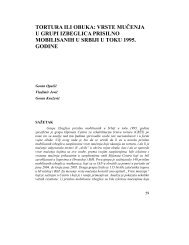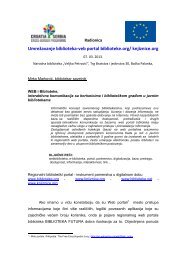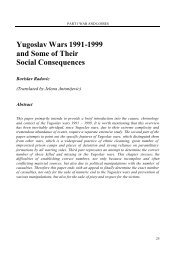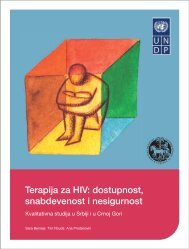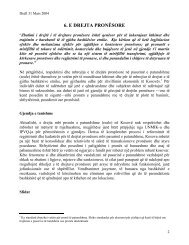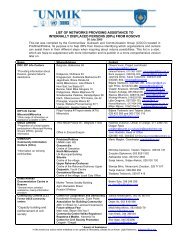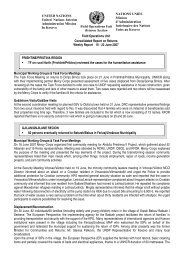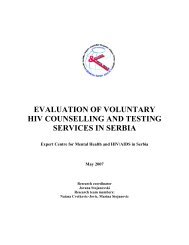Psychological Preparation of Torture Victims as Witnesses toward ...
Psychological Preparation of Torture Victims as Witnesses toward ...
Psychological Preparation of Torture Victims as Witnesses toward ...
Create successful ePaper yourself
Turn your PDF publications into a flip-book with our unique Google optimized e-Paper software.
PART VII LEGAL AND PSYCHIATRIC ASPECTS<br />
<strong>Psychological</strong> <strong>Preparation</strong><br />
<strong>of</strong> <strong>Torture</strong> <strong>Victims</strong> <strong>as</strong> <strong>Witnesses</strong> <strong>toward</strong><br />
the Prevention <strong>of</strong> Retraumatisation<br />
Zoran Ilic<br />
(Translated by Jelena Antonijevic)<br />
Abstract<br />
This work presents psychological specificities <strong>of</strong> situations where torture victims are<br />
witnesses at the court trial <strong>of</strong> perpetrators at the same time. <strong>Witnesses</strong> are subject to the<br />
risk <strong>of</strong> secondary traumatisation, retraumatisation and revictimatisation, which may lead to<br />
the deterioration <strong>of</strong> existing PTSD symptoms. Starting from the very act <strong>of</strong> reaching the<br />
decision whether to testify, witnesses are in a state <strong>of</strong> ambivalence <strong>as</strong>sociated with a need<br />
for truth and justice, the need that perpetrators should be adequately punished and thus<br />
certain compensation be provided <strong>as</strong> well <strong>as</strong> with fear <strong>of</strong> the course that the trial itself may<br />
take, they being partially aware <strong>of</strong> the risk for retraumatisation and retraumatisation. The<br />
author sets forth the need for psychological-psychiatric preparation <strong>of</strong> the witness prior to<br />
the trial, <strong>as</strong> well <strong>as</strong> co-operation between judicial organs and psychiatric-psychological<br />
service. The paper features examples from the Centre for Rehabilitation <strong>of</strong> <strong>Torture</strong> <strong>Victims</strong><br />
– IAN Belgrade.<br />
377
TORTURE IN WAR: CONSEQUENCES AND REHABILITATION OF VICTIMS<br />
INTRODUCTION<br />
One <strong>of</strong> b<strong>as</strong>ic aims <strong>of</strong> torture is to bring a person down to a position <strong>of</strong> extreme helplessness<br />
leading to a deterioration <strong>of</strong> cognitive, emotional and behavioural functions. The camp<br />
detention and exposure to psychophysical torture also results in damages <strong>of</strong> b<strong>as</strong>ic<br />
psychological and social functioning, the aim <strong>of</strong> torture being not only to physically break<br />
the victim but also to lead to the disintegration <strong>of</strong> his/her personality, its purpose being to<br />
destroy relations with family and society in their entirety, wreck fant<strong>as</strong>ies and hopes in<br />
better future. Victimisation represents the result <strong>of</strong> jeopardising fundamental<br />
preconceptions <strong>of</strong> an individual and his/her life. Those are preconceptions <strong>of</strong> personal<br />
inviolability, an <strong>as</strong>sumption that the world h<strong>as</strong> its meaning and order and a positive self<br />
perception (Jan<strong>of</strong>f-Bulman & Frieze, 1983).<br />
Besides bodily harm and permanent disability <strong>as</strong> a consequence <strong>of</strong> psychophysical<br />
ill-treatment, posttraumatic stress disorder (PTSD) represents one <strong>of</strong> the most frequently<br />
established psychiatric diagnoses in torture victims, but <strong>of</strong>ten there are concomitant<br />
psychiatric dise<strong>as</strong>es such <strong>as</strong> alcohol dependence, depressive disorder, anxious, dissociative,<br />
somat<strong>of</strong>orm and even psychotic disturbances (Arthur, 1982). <strong>Torture</strong> exposure may lead to<br />
permanent personality disorders after cat<strong>as</strong>trophic experience, which is manifested through<br />
withdrawal from social communications and an experience <strong>of</strong> the world <strong>as</strong> a menace<br />
accompanied by constant distrust.<br />
War crimes are imprescriptible and it is supposed that their perpetrators will be<br />
brought to justice when torture victims become key witnesses in court. Thus, one person<br />
may unite the victim, witness and patient regardless <strong>of</strong> the fact whether the person h<strong>as</strong><br />
received treatment or not so far.<br />
In the eyes <strong>of</strong> the victim justice h<strong>as</strong> different meaning and expectations vary: e.g. a<br />
person with an experience that he/she enjoys greater rights may expect higher reparation, or<br />
an individual with previous deprivations might paradoxically believe that he/she should<br />
receive more due to other »damages« in his/her life, while others may demand social<br />
injustice compensation (Raphael, 1992).<br />
IMPORTANCE OF TESTIMONY FOR THE VICTIM-WITNESS<br />
No social process may annul the extreme torture effect. An impartial court trial <strong>of</strong><br />
perpetrators may to a certain extent alleviate effects <strong>of</strong> a traumatic event, while, on the<br />
other hand, the torture victims’ testimony is at the same time desirable and also problematic<br />
for the victim. It is desirable, since thus justice is satisfied and moral postulates undermined<br />
by torture are re-established and faith in people regained. Their testimony h<strong>as</strong> a wider<br />
historical function - »the crime committed is not to be forgotten « by the disclosure <strong>of</strong> the<br />
truth, which is a step requisite for the transformation <strong>of</strong> interethnic conflicts (Ilic, 2002).<br />
378
TORTURE IN WAR: CONSEQUENCES AND REHABILITATION OF VICTIMS<br />
<strong>of</strong> a court process <strong>as</strong> an essential part <strong>of</strong> a wished-for outcome <strong>of</strong> punishing <strong>of</strong><br />
perpetrators. 1 The justice system, with all its good intentions, may neglect and fail to<br />
recognise the needs <strong>of</strong> a victim appearing in the role <strong>of</strong> a witness. The court process may<br />
result in retraumatisation thus worsening the victim’s existing psychological state, even it a<br />
complete recovery h<strong>as</strong> been previously achieved.<br />
As early <strong>as</strong> 1980 Symonds w<strong>as</strong> the first to analyse the nature <strong>of</strong> this “second<br />
injury”) to victims (Symonds, 1980). He described 4 ph<strong>as</strong>es <strong>of</strong> responses . The first two<br />
ph<strong>as</strong>es represent an acute response to a sudden, unexpected violence; namely: shock and<br />
disbelief and “frozen fear” which he describes <strong>as</strong> terror-induced, pseudo-calm detached<br />
behaviour. The third ph<strong>as</strong>e is “traumatic depression” but much <strong>of</strong> what is now subsumed in<br />
PTSD, characterised by apathy, anger, resignation, rage, startle reactions, reliving<br />
symptoms and nightmares. The fourth ph<strong>as</strong>e comprises resolution and integration <strong>of</strong><br />
experiences into life style and behaviour. This second injury occurs when the victim<br />
perceives rejection or a lack <strong>of</strong> anticipated support from his/her family or society which<br />
leads to the sense <strong>of</strong> helplessness. Another component <strong>of</strong> second trumatisation is the failure<br />
to allow the telling <strong>of</strong> the story, the giving <strong>of</strong> testimony, which leads to the failure to<br />
recognise one’s own strengths and restore a sense <strong>of</strong> control over one’s own life.<br />
Many victims fail to testify in court due to various re<strong>as</strong>ons. In the investigations by<br />
Davis in other criminal literature fully 50% <strong>of</strong> victims do not want to testify, and one in<br />
three refuses to appear in court (Davis, 1992). B<strong>as</strong>ic re<strong>as</strong>ons lie in the lack <strong>of</strong> confidence in<br />
jurisdiction and justice system <strong>as</strong> well <strong>as</strong> the fear <strong>of</strong> retraumatisation (Kidd & Cajet, 1984).<br />
In torture victims distrust in jurisdiction constitutes a part <strong>of</strong> general distrust in the<br />
institutions <strong>of</strong> a system and feeling that guilty persons (perpetrators <strong>of</strong> crimes) will not be<br />
adequately punished due to political re<strong>as</strong>ons, especially not in c<strong>as</strong>e that trial is held in the<br />
country where the traumatic experience previously occurred.<br />
The fear <strong>of</strong> retraumatisation may also be understood <strong>as</strong> a portion <strong>of</strong> symptoms <strong>of</strong><br />
avoidant behaviours within PTSD. A traumatic experience jeopardises the cognitive<br />
balance <strong>of</strong> the traumatic experience victim who is motivated to behave either completely<br />
differently than the negatively formed cognitive patterns or in compliance with them, or the<br />
warning signals are overestimated which leads to constant anxiety and avoidance, or<br />
underestimated which leads to revictimatisation. Sometimes there is also a phenomenon <strong>of</strong><br />
compulsion to repeat the trauma (van der Kolk, 1989) while sometimes there occurs a<br />
pathological thirst for a revenge out <strong>of</strong> querulous motives being a consequence <strong>of</strong> paranoid<br />
disorders.<br />
A series <strong>of</strong> factors throughout the very course <strong>of</strong> trial and preliminary<br />
investigation proceedings may result in retraumatisation.<br />
Even prior to the commencement <strong>of</strong> court proceedings the victim’s reflections on<br />
the court process, his/her decision-making with regard to whether to testify in court,<br />
security me<strong>as</strong>ures prior to and following the court proceedings, language barrier and<br />
1 Office <strong>of</strong> Crime Statistics, Attorney General's Department South Australia, Adelaide: <strong>Victims</strong>&Criminal<br />
Justice, 1990.<br />
380
PART VII LEGAL AND PSYCHIATRIC ASPECTS<br />
anticipation <strong>of</strong> cultural differences, thoughts <strong>of</strong> transportation to the court (frequently<br />
agoraphobia manifested by an avoidance <strong>of</strong> means <strong>of</strong> transport) <strong>as</strong> well may be a source <strong>of</strong><br />
anticipatory anxiety, sometimes up to the level <strong>of</strong> panic. Retraumatisation may commence<br />
with an investigation procedure and method in which testimony is conducted by an<br />
examining judge.<br />
The court process retraumatise the victim-witness in several ways: the justice<br />
system may disempower the witness out <strong>of</strong> ignorance <strong>of</strong> psychological-psychiatric<br />
guidelines related to victim’s psychological-psychiatric state <strong>as</strong> well <strong>as</strong> due to ritual<br />
practices and the status <strong>of</strong> the witness in the hierarchy <strong>of</strong> power that exists within the justice<br />
system. The court proceeding and attendance in the courtroom may reactivate memories for<br />
a previous attendance in the courtroom in c<strong>as</strong>e that court proceedings were conducted<br />
against the victim. Even if it is not a c<strong>as</strong>e, the victim may experience it <strong>as</strong> a trial against<br />
him/her not against the accused persons. The encounter with the accused is almost always<br />
dramatic and retraumatising. The identification <strong>of</strong> one’s own torturers presents acute stress<br />
and reactions to it are <strong>of</strong>ten dramatic. Loss <strong>of</strong> consciousness and attention is likely to occur<br />
<strong>as</strong> well <strong>as</strong> triggering <strong>of</strong> dissociative defensive mechanisms, disorientation up to<br />
psychogenic stupor or less frequently agitation <strong>as</strong> well <strong>as</strong> a loss <strong>of</strong> control over aggressive<br />
impulses. Frequently it is accompanied by vegetative signs <strong>of</strong> panic anxiety. Such<br />
symptoms may to a great extent influence or make testifying entirely impossible in the<br />
further course <strong>of</strong> court proceedings.<br />
<strong>Victims</strong> may have difficulties in the verbalisation <strong>of</strong> a traumatic experience due to<br />
the fact that Broca’s area <strong>of</strong> the brain is »shut down « throughout a trauma <strong>as</strong> we ll <strong>as</strong> due to<br />
the long-term biological brain damages – the hippocampus cells death- caused by an abrupt<br />
elevation <strong>of</strong> stress hormones and memory impairment (van der Kolk, 1996). Also, the<br />
survivor is <strong>of</strong>ten not able to describe what h<strong>as</strong> happened to him since he/she lost<br />
consciousness or suffered a head injury. Further memory impairment may also ensue from<br />
a frequent alcohol abuse. Some witnesses may fill »holes in memory « by confabulations.<br />
The defence <strong>of</strong> the accused may make the victim-witness feels powerless and put<br />
him/her in the position in which he/she h<strong>as</strong> to »prove« his/her traumatic experience and<br />
suffering, while this certainly does not represent a framework for resolution <strong>as</strong> a victim’s<br />
central need, but for retribution, reparation or sentence 6 which is a function <strong>of</strong> the justice<br />
system. In the eyes <strong>of</strong> the victim, the behaviour <strong>of</strong> the defence is felt <strong>as</strong> an attack, charge<br />
and accusation which may cause an experience <strong>of</strong> humiliation and deepen uncertainty.<br />
Especially stress-inducing experience for a victim represents cross-examination.<br />
The atmosphere during trial, especially if the trial is held in the place where the<br />
accused come from or even where the traumatic experience occurred, may to a great extent<br />
revictimise the witness. Praises to the accused and their glorification <strong>as</strong> heroes accompanied<br />
by the insulting <strong>of</strong> the victim may deepen an experience <strong>of</strong> injustice and cause a series <strong>of</strong><br />
emotional reactions which are intensive and overwhelming, deactivate usual stress coping<br />
strategies and reactivate PTSD symptoms.<br />
381
TORTURE IN WAR: CONSEQUENCES AND REHABILITATION OF VICTIMS<br />
VICTIM-WITNESS PSYCHOLOGICAL PREPARATION<br />
While the victim’s needs received little attention in the p<strong>as</strong>t, interest in legal and<br />
psychosocial <strong>as</strong>sistance to witnesses in criminal procedures h<strong>as</strong> grown all over the world.<br />
There have been a large number <strong>of</strong> centres and services for support to witnesses opened<br />
aimed at the provision <strong>of</strong> information and <strong>as</strong>sistance to witnesses.<br />
The b<strong>as</strong>ic objective <strong>of</strong> the psychological preparation <strong>of</strong> the witness is the<br />
prevention <strong>of</strong> retraumatisation and revictimatisation. The best preparation <strong>of</strong> the witness for<br />
testimony delivery in court is a usual therapeutic procedure applied in the every day<br />
psychological-psychiatric practice which must be commenced <strong>as</strong> early <strong>as</strong> possible<br />
regardless <strong>of</strong> the fact whether the torture victim is to testify or not. Therefore an approach<br />
to the traumatised person does not differ much dependent on the fact whether the person<br />
h<strong>as</strong> already received a treatment or he/she, having already decided to testify, is coming for<br />
the first time, <strong>as</strong>king for psychological <strong>as</strong>sistance on that occ<strong>as</strong>ion. Here, in order to<br />
determine an appropriate type <strong>of</strong> intervention, an important role also plays the factor <strong>of</strong><br />
time remaining up to the court process.<br />
At all events, every psychological-psychiatric intervention must be modulated in<br />
such a way which ensures that any disruption <strong>of</strong> the statement authenticity is avoided and<br />
no distortion <strong>of</strong> facts throughout court process is caused or no impact on the witness and<br />
his/her testimony in court is made in any other way. It is groundless to believe that<br />
psychological and psychiatric interventions, regardless <strong>of</strong> the type <strong>of</strong> psychiatric method<br />
used, may to a varying extent impair memory. We share Alexander’s opinion that »A<br />
person is not restored to health remembering but starts to remember restoring health«.<br />
Psychotherapy in work with the traumatised is aimed to reduce the level <strong>of</strong> overwhelming<br />
emotions jeopardising the process <strong>of</strong> thinking thus alleviating potential effects <strong>of</strong><br />
retraumatisation.<br />
The psychiatrist’s role is not without an impact on the patient’s decision and will<br />
to participate in the court proceeding <strong>as</strong> a witness. A successful psychiatric therapy is<br />
supposed to ensure a patient’s better insight into a situation and e<strong>as</strong>ier decision-making due<br />
to the reduction <strong>of</strong> symptoms and restoration <strong>of</strong> self-esteem. Thus empowered, the torture<br />
victim with less difficulty accepts the court process and determines to testify.<br />
Beside the fact that a therapist does not try to persuade or convince the patient to<br />
make his decision to testify, he/she should <strong>as</strong>sume an unambiguous and clear attitude that<br />
<strong>of</strong>fenders must be identified and punished, since therapeutic neutrality may be understood<br />
<strong>as</strong> forgiving the perpetrator <strong>of</strong> the crime. This also enables b<strong>as</strong>ic patient’s confidence in<br />
his/her therapist to be established. Balanced provision <strong>of</strong> necessary information on the court<br />
process and possible sources <strong>of</strong> fear likely to occur throughout the court trial may reduce<br />
irrational fears. Balance is indispensable to avoid an incre<strong>as</strong>e in fear and anxiety. Besides,<br />
all the time a therapist should also be aware and certain <strong>of</strong> the fact that the benefits from the<br />
intervention far outweigh possible adverse effects.<br />
382
PART VII LEGAL AND PSYCHIATRIC ASPECTS<br />
Concurrently, a therapist must be aware <strong>of</strong> the needs <strong>of</strong> the victim, which directs<br />
and determines the further approach. These needs entail the respect <strong>of</strong> their (victims’)<br />
boundaries, the need to feel acknowledged, not <strong>as</strong>sessed, to talk and be listened to, to pay<br />
attention to their feelings and to recognise their individual time lines <strong>of</strong> recovery.<br />
Therefore, the therapist’s approach should allow presence, care, listening and empathy,<br />
with the optimum me<strong>as</strong>ure <strong>of</strong> neutrality retained. Special care should be taken that the<br />
setting provides an intimate and comfortable atmosphere and that all objects are visible (the<br />
absence <strong>of</strong> screen) always bearing in mind that tension may provoke the presence <strong>of</strong> things<br />
which we pay no attention to. Any possibility <strong>of</strong> surprise should be carefully eliminated to<br />
ensure the patient’s sense <strong>of</strong> control.<br />
The objectives <strong>of</strong> psychological preparation are: the diagnostics <strong>of</strong> current<br />
psychiatric disorders and their healing <strong>as</strong> well <strong>as</strong> the reduction <strong>of</strong> anticipatory anxiety<br />
related to the litigation process. It is necessary to establish a diagnosis in order to determine<br />
a strategy <strong>of</strong> further therapeutic treatment <strong>as</strong> well <strong>as</strong> predict possible reactions throughout<br />
the court process. Diagnostic documents may also have forensic significance in the event <strong>of</strong><br />
forensic expertise or compensation proceedings.<br />
Components <strong>of</strong> CISD (Critical Incidence Stress Debriefing; Busuttil et al., 1995),<br />
crisis interventions, cognitive behavioural methods which also encomp<strong>as</strong>s EMDR (Eye<br />
Movement Desensitisation and Reprocessing) are used for therapeutic purposes, but brief<br />
focused analytically oriented methods and supportive psychotherapy are also applied. The<br />
reduction <strong>of</strong> anxiety is achieved by means <strong>of</strong> relaxation techniques. Frequently it is<br />
necessary to administer psychotropic drugs in the course <strong>of</strong> a certain period prior to and<br />
immediately before the court trial. Besides anxiolytics and hypnotics, beta blockers may<br />
also be administered while the administration <strong>of</strong> antidepressants should be introduced at<br />
le<strong>as</strong>t a month prior to the court process.<br />
In many courts throughout the world there are services providing support to<br />
victims whose staff also include psychologists and social workers. Such a pr<strong>of</strong>ile <strong>of</strong> experts<br />
is especially required in courts where war crimes are processed (e.g. the International<br />
Criminal Tribunal for the Former Yugoslavia in The Hague) and their role is clear in the<br />
period prior to, during and after the testimony. Prior to the testimony the victim is<br />
confronted with an unpredictable period <strong>of</strong> waiting, closed or isolated environment,<br />
expectation <strong>of</strong> the unknown, cultural and language barriers, and so forth. The psychological<br />
preparation in this ph<strong>as</strong>e is aimed at helping the person to relax, which is achieved by<br />
constant informing, paying attention to practical needs and relief from anxiety.<br />
During the court proceedings, which represents the mo st stress-inducing part, the<br />
best prevention <strong>of</strong> retraumatisation is achieved by means <strong>of</strong> technical me<strong>as</strong>ures for the<br />
witness protection such <strong>as</strong>: testimony delivery in writing or behind the screen or via direct<br />
television transmission, by which the direct confrontation with the accused is avoided<br />
unless the witness himself/herself insists on the direct confrontation. The psychological<br />
support throughout the litigation is limited to the provision <strong>of</strong> surroundings which allows<br />
rele<strong>as</strong>e, rest and self-possession. Here attention should be also paid to the practical needs,<br />
383
TORTURE IN WAR: CONSEQUENCES AND REHABILITATION OF VICTIMS<br />
maintenance <strong>of</strong> the link between the witness and court procedure and the relief from strong<br />
emotions with their control and restraint.<br />
Following the court process the witness faces the experience that the work h<strong>as</strong><br />
been done, but there is the need for feedback information on his/her testimony accompanied<br />
by the sense <strong>of</strong> accomplishment. There is still a high degree <strong>of</strong> excitement with the<br />
symptoms <strong>of</strong> an irritated vegetative nervous system present. Of the psychological<br />
interventions CISD is applied and the aim is to unite the p<strong>as</strong>t, present and future.<br />
Throughout the very court trial the presence <strong>of</strong> a psychologist, psychiatrist or<br />
trained social worker in c<strong>as</strong>e <strong>of</strong> the most severely traumatised persons may be <strong>of</strong> decisive<br />
importance for the reduction <strong>of</strong> symptoms, though the presence <strong>of</strong> a witness co-ordinator<br />
seems justified to us, provided that this person is known and trusted by the witness. This<br />
person, <strong>of</strong> course, may be a psychologist or psychiatrist from the preparation ph<strong>as</strong>e. If this<br />
is impossible to achieve, it is requisite to ensure the co-operation between the court support<br />
staff and psychiatrists and psychologists who know the witness quite well and who took<br />
part in his/her preparation. The co-operation should commence well before the trial itself by<br />
the exchange <strong>of</strong> information and diagnostic results, which signalises possible reactions.<br />
Also, it is necessary that feedback information be provided by the court so that the<br />
monitoring <strong>of</strong> the witness’s psychological condition may also be continued for a long time<br />
upon the completion <strong>of</strong> the trial expressly due to the possible l<strong>as</strong>ting consequences <strong>of</strong><br />
retraumatisation.<br />
PSYCHOLOGICAL PREPARATION EXPERIENCES OF THE CENTRE FOR<br />
REHABILITATION OF TORTURE VICTIMS – IAN BELGRADE<br />
The court process against eight former military policemen charged for maltreatment in the<br />
prison camp Lora w<strong>as</strong> to a great extent commenced due to the endeavours <strong>of</strong> the Croatian<br />
non-governmental organisation Altruist Centre for Protection <strong>of</strong> Human Rights and<br />
Freedoms. From the moment <strong>of</strong> summoning 14 witnesses <strong>of</strong> the SR Yugoslavia for the<br />
Principle Debate in the Court <strong>of</strong> Split, the Centre for Rehabilitation <strong>of</strong> <strong>Torture</strong> <strong>Victims</strong> –<br />
IAN Belgrade (CRTV) launched its co-operation with the Altruist Centre. The IAN<br />
representative together with the Altruist representative contacted and visited all the<br />
witnesses with the aim <strong>of</strong> motivating them to testify and informing on the security<br />
me<strong>as</strong>ures.<br />
There were five psychiatrists and five psychologists engaged in the psychological<br />
portion <strong>of</strong> preparation. Apart from an enormous effort and work on motivation invested, <strong>of</strong><br />
fourteen potential witnesses only five victims <strong>of</strong> torture in the Lora came to attend the<br />
psychological preparation. This is not hard to understand considering the fact that the trial<br />
w<strong>as</strong> held in Split, the town where the potential witnesses were exposed to torture and that<br />
that their fear w<strong>as</strong> real apart from all the promised security me<strong>as</strong>ures. Also, the majority <strong>of</strong><br />
the witnesses have their family me mbers in Croatia and they are worried about their<br />
security following the trial <strong>as</strong> well.<br />
384
PART VII LEGAL AND PSYCHIATRIC ASPECTS<br />
The preparation l<strong>as</strong>ted two days, 7 hours per day including the joint working lunch<br />
break. On the first day, the activities encomp<strong>as</strong>sed the meeting with the people summoned<br />
to testify in the Lora c<strong>as</strong>e, attendance at the preparation meeting conducted with them by<br />
the activist <strong>of</strong> the Altruist Centre from Split, engaged in the search for witnesses and<br />
<strong>as</strong>sistance in safeguarding their security me<strong>as</strong>ures in the course <strong>of</strong> their stay in Croatia. The<br />
first day p<strong>as</strong>sed primarily in informing the potential clients on all the relevant issues with<br />
regard to their departure for Croatia, that is, protection me<strong>as</strong>ures to be provided to them, <strong>as</strong><br />
well <strong>as</strong> in the motivation <strong>of</strong> these people to co-operate with the IAN psychologists and<br />
psychiatrists, regardless <strong>of</strong> their decision whether to testify or not.<br />
The second day focused on diagnostics and psychiatric work on the prevention <strong>of</strong><br />
retraumatisation. The diagnostic <strong>as</strong>sessment w<strong>as</strong> performed by the psychologists b<strong>as</strong>ed on<br />
interviews (Structured Clinical Psychiatric Interview - SCID-I; Spitzer, Williams &<br />
Gibbon, 1992, Clinician Administered PTSD Scale for DSM-IV – CAPS; Blake et al.,<br />
1990), and a battery <strong>of</strong> tests (Impact <strong>of</strong> Event Scale – IES; Horowitz, Wilner & Alvarez,<br />
1979, Symptom Check List Scale - revised version - SCL-90-R; Derogatis et al., 1974, Types<br />
<strong>of</strong> torture - VM). In the majority <strong>of</strong> the clients there w<strong>as</strong> either current, chronic or lifetime<br />
PTSP diagnosed. The two patients had already undergone psychiatric treatment for tortureinduced<br />
psychotic disorders. The second part <strong>of</strong> the work consisted <strong>of</strong> individual sessions.<br />
In two c<strong>as</strong>es the EMDR – method w<strong>as</strong> applied, <strong>as</strong> well <strong>as</strong> supportive psychotherapy<br />
including the counselling how to cope with the stress throughout the trial.<br />
It h<strong>as</strong> been perceived that generally the work had positive effects on the patients,<br />
especially when the EMDR method w<strong>as</strong> applied, by means <strong>of</strong> which successful<br />
desensitization <strong>of</strong> traumatic events w<strong>as</strong> achieved. Following the session, all the patients<br />
reported a reduction <strong>of</strong> excitement on the appropriate self-report scale, there w<strong>as</strong> complete<br />
cognitive restructuring achieved, also validated on the appropriate self-report scale, <strong>as</strong> well<br />
<strong>as</strong> the relaxation <strong>of</strong> body which resulted in the integration <strong>of</strong> traumatic experiences. All the<br />
patients stayed in contact with us and they were <strong>of</strong>fered, unless they are already the clients<br />
<strong>of</strong> our centre, to keep coming to our CRTV and continue the launched psychotherapeutic<br />
work. However, none <strong>of</strong> the witnesses attended the trial in Split <strong>as</strong> all the security<br />
conditions were not provided, which w<strong>as</strong> also the recommendation <strong>of</strong> the governmental<br />
bodies <strong>of</strong> the FR Yugoslavia.<br />
CONCLUSIONS AND RECOMMENDATIONS<br />
<strong>Torture</strong> victims represent the population which is the most endangered by war traum<strong>as</strong>.<br />
Testimony in court h<strong>as</strong> a reparatory, compensatory and healing function for the victim, at<br />
the same time also representing a possibility <strong>of</strong> retraumatisation and deterioration <strong>of</strong> the<br />
victim’s psychological condition. We support psychological preparation which is to be<br />
conducted by educated psychologists and psychiatrists who should also attend the complete<br />
trial process. <strong>Witnesses</strong> should be protected to a maximum degree from revictimatisation in<br />
court. In c<strong>as</strong>e that the psychological preparation is taken over by the service for<br />
victim/witness support, close co-operation with psychiatrists and psychologists who carried<br />
385
TORTURE IN WAR: CONSEQUENCES AND REHABILITATION OF VICTIMS<br />
out the preparation is necessary. Also, there is an essential need for constant sensitization <strong>of</strong><br />
lawyers participating in the trial commencing from investigatory bodies through judges and<br />
lawyers <strong>of</strong> the accused in order to prevent the retraumatisation and revictimatisation <strong>of</strong><br />
torture victim-witnesses.<br />
386
PART VII LEGAL AND PSYCHIATRIC ASPECTS<br />
REFERENCES<br />
American Psychiatric Association (1994) Diagnostic and Statistical Manual <strong>of</strong> Mental Disorders, Fouth Edition<br />
(DSM-IV). W<strong>as</strong>hington, D.C.: American Psychiatric Press.<br />
Arthur, R.J. (1982) Psychiatric syndromes in prisoners <strong>of</strong> war and concentration camp survivors. In: Friedmann,<br />
C.T.H. and Faguet, R.A., (Eds.) Extraordinary Disorders <strong>of</strong> Human Behavior, New York: Plenum<br />
Pub Corp.<br />
Busuttil, W., Turnbull, G.J., Neal, L.A., Rollins, J., West, A.G., Blanch, N. and Herepath, R. (1995) Incorporating<br />
psychological debriefing techniques within a brief group psychotherapy program for the treatment <strong>of</strong><br />
post-traumatic stress disorder. British Journal <strong>of</strong> Psychiatry 167, 495-502.<br />
Cienfuegos, A. and Monelli C. (1983) The testimony <strong>of</strong> political repression <strong>as</strong> a therapeutic instrument.<br />
American Journal <strong>of</strong> Orthopsychiatry 53, 43-51.<br />
Daly, R.J. (1980) Compensation and rehabilitation <strong>of</strong> victims <strong>of</strong> torture: an example <strong>of</strong> preventive psychiatry.<br />
Danish Medical Bulletin 27, 245-248.<br />
Davis, R. (1992) Impact Statements Not Having Much Effect. NOVA Newsletter 16, 2<br />
Ilic Z. (2002) Prihvatanje istine - korak ka pomirenju? Temida 4, 9-15.<br />
Jan<strong>of</strong>f-Bulman, R. and Frieze, I.H. (1983) A theoretical persepctive for understanding reactions to victimisation.<br />
Journal <strong>of</strong> Social Issues 39, 1-17.<br />
Kelly, D.P. (1984) Delivering Legal Services to <strong>Victims</strong>: An Evaluation and Prescription. Justice System Journal<br />
9, 60-62.<br />
Kidd, R.F. and Chajet, E.F. (1984) Why <strong>Victims</strong> Fail to Report? The Psychology <strong>of</strong> Criminal Victimization.<br />
Journal <strong>of</strong> Social Issues 40, 35-50.<br />
Kilpatrick D G and Tidwell R P (1989) <strong>Victims</strong>' Rights and Services in South Carolina: The Dream, The Law, the<br />
Reality, Final Report . Charleston, SC: Crime <strong>Victims</strong> Research and Treatment Center, Medical<br />
University <strong>of</strong> South Carolina.<br />
Office <strong>of</strong> Crime Statiscics (1990) <strong>Victims</strong>&Criminal Justice. Adelaide: Attorney General's Department South<br />
Australia.<br />
Raphael B (1992) The Victim the Trauma & Justice. Internet article:<br />
www.justice.net.au/publications/mc_book/victim.pdf<br />
Steinmetz, C.H.D. (1984) Coping with a serious crime: Self-help and outside help. Victimology 9, 324-343.<br />
Svetska zdravstvena organizacija (1992) ICD-10 Kl<strong>as</strong>ifikacija mentalnih poremecaja i poremecaja ponašanjaklinicki<br />
opisi i dijagnosticka uputstva [WHO: The ICD-10 Cl<strong>as</strong>sification <strong>of</strong> Mental and Behavioural<br />
Disorders: Clinical Descriptions and Diagnostic Guidelines]. Beograd : Zavod za udžbenike i n<strong>as</strong>tavna<br />
sredstva.<br />
Symonds, M. (1980) The "second injury" to victims. Evaluation and Change. (special issue), 36-38.<br />
van der Kolk, B. (1989) The Compulsion to Repeat the Trauma. Re-enactment, Revictimization, and M<strong>as</strong>ochism.<br />
Psychiatric Clinics <strong>of</strong> North America 12, 389-411.<br />
van der Kolk, B.A. (1996) The body keeps the score: Approaches to the psychobiology <strong>of</strong> post-traumatic stress<br />
disorder. In: van der Kolk, B.A., McFarlane, A. and Weisaeth, L., (Eds.) Traumatic Stress - The<br />
Effects <strong>of</strong> Overwhelming Experience on Mind, Body and Society, pp. 214-241. New York/London:<br />
The Guilford Press.<br />
387




